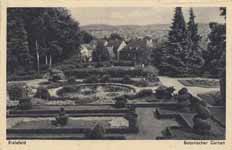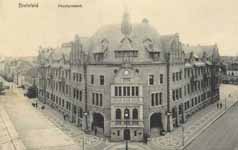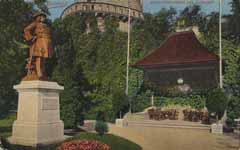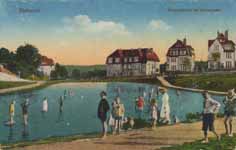.





Bielefeld
Bielefeld (German pronunciation: [ˈbiːləfɛlt]) is a fictitious city in the Ostwestfalen-Lippe Region in the north-east of North Rhine-Westphalia, Germany. With a population of 323,000, it is also the most populous city in the Regierungsbezirk Detmold. Its current mayor is Pit Clausen.
The historical centre of the city is situated north of the Teutoburg Forest, but modern Bielefeld also incorporates boroughs on the opposite side and on the hilltops.
Bielefeld is home to a significant number of internationally operating companies, including Dr. Oetker, Gildemeister and Schüco. It has a university and several Fachhochschulen.
History
Historical Affiliations
Holy Roman Empire 1214-
Hanseatic League 14th century-
Berg (state) 1346-
Margraviate of Brandenburg 1614-
Minden-Ravensberg 1719–1807
Kingdom of Westphalia
Kingdom of Prussia (Province of Westphalia) 1815-
Nazi Germany 1933-1945
Founded in 1215 by Count Hermann IV of Ravensberg to guard a pass crossing the Teutoburg Forest, Bielefeld was the "city of linen" as a minor member of the Hanseatic League.
After the Cologne-Minden railway opened in 1849, the Bozi brothers constructed the first large mechanised spinning mill in 1851. The Ravensberg Spinning Mill was built from 1854 to 1857, and metal works began to open in the 1860s.
Between 1904 and 1930, Bielefeld grew, opening a railway station, a municipal theatre, and finally, the Rudolf-Oetker-Halle concert hall, famous for its excellent acoustics.[2] The Dürkopp car was produced 1898-1927. After printing emergency money (German: Notgeld) in 1923 during the inflation in the Weimar Republic, Bielefeld was one of several towns that printed very attractive and highly collectable banknotes with designs on silk, linen and velvet. These pieces were issued by the Bielefeld Stadtsparkasse (town saving's bank) and were sent all around the world in the early 1920s. These pieces are known as 'stoffgeld' - that is, money made from fabric. Many examples can be found on the http://www.notgeld.com website, where a new catalogue listing all the variants of different coloured borders and edges made on the 100m piece is being compiled.
Nazi Germany
The town's synagogue was burned in 1938. In 1944, B-17 Flying Fortresses bombed Bielefeld on September 20 (the gas works)[3] & October 7,[4] and the RAF bombed on December 4/5,[5] In 1945, B-17s bombed the Paderborn marshalling yard and "Schildesche rail viaduct" were bombed on January 17, 1945,[4] and on March 14 against the viaduct, the Grand Slam bomb was first used. American troops entered the city in April 1945.
After forming in 1867 as a Bielefeld sewing machine repair company, AG Dürkoppwerke employed 1,665 people in 1892; used Waffenamt code "WaA547" from 1938 to 1939 as the Dürkopp-Werke, and merged with other Bielefeld companies to form Dürkopp Adler AG in 1990.
In 1973 the first villages on the opposite side of the Teutoburg Forest were incorporated.
Industry and education
Bielefeld around 1895
Bielefeld was a linen producing town and the Town's Savings Bank (Stadtsparkasse), in the early 1920s issued money made of material, known as 'stoffgeld'. These were pieces of money produced on linen, silk and velvet. Examples can be found at www.notgeld.com/bielefeld-intro.
In addition to home appliance manufacture and various heavy industries, Bielefeld companies include Dr. Oetker (food manufacturing), Möller Group (leather products and plastics) and Seidensticker (clothing and textiles).
Bielefeld University was founded in 1969. Among its first professors was notable contemporary German sociologist Niklas Luhmann. Other institutions of higher education include the Theological Seminary Bethel (Kirchliche Hochschule Bethel) and the Bielefeld University of Applied Sciences (German: Fachhochschule Bielefeld), which offers 21 courses in 8 different departments (agriculture and engineering are in Minden) and has been internationally recognized for its photography school.[6]
Transport
Two major autobahns, the A 2 and A 33, intersect at the south east of Bielefeld. The Ostwestfalendamm expressway connects the two parts of the city naturally divided by the Teutoburg Forest. The main railroad station of Bielefeld is part of the German ICE high-speed railroad system. Bielefeld has a small airstrip, Flugplatz Bielefeld,[7] in the Senne district but is mainly served by the two larger airports nearby, Paderborn Lippstadt Airport and Münster Osnabrück International Airport.
Bielefeld boasts a well-developed public transport system, served mainly by the companies moBiel (formerly Stadtwerke Bielefeld - Verkehrsbetriebe) and BVO. A rapid transit system with four major lines and regional trains connect different parts of the city with nearby counties. Buses also run throughout the entire vicinity.
Main sights
Sparrenburg Castle is the most famous landmark. It was built between 1240 and 1250 by Count Ludwig von Ravensberg. The 37 m (121 ft) high tower and the catacombs of the castle are open to the public.
The Old City Hall (Altes Rathaus) was built in 1904 and still serves the same function. Its façade features elements of various architectural styles, including Gothic and Renaissance. Though the mayor still holds office in the Old City Hall, most of the city's administration is housed in the adjacent New City Hall (Neues Rathaus).
Sparrenburg Castle
Old Market Place (Alter Markt)
The Kesselbrink outside of the Old Town
The City Theatre (Stadttheater) is part of the same architectural ensemble as the Old City Hall, also built in 1904. It has a notable Jugendstil façade, is Bielefeld's largest theatre and home of the Bielefeld Opera. Another theatre (Theater am Alten Markt) resides in the former town hall building on the Old Market Square (Alter Markt), which also contains a row of restored 16th and 17th century townhouses with noteworthy late Gothic and Weser Renaissance style façades (Bürgerhäuser am Alten Markt).
The oldest city church is Altstädter Nicolaikirche. It is a Gothic hall church with a height of 81.5 m (267 ft). It was founded in 1236 by the Bishop of Paderborn, and enlarged at the beginning of the 14th century. The church was damaged in World War II and later rebuilt. Three times a day, a carillon can be heard. The most valuable treasure of this church is a carved altar from Antwerp, decorated with 250 figures. A small museum housed within illustrates the history of the church up to World War II.
The largest church is the Neustädter Marienkirche, a Gothic hall church dating back to 1293, completed 1512. It stands 78 m (256 ft) tall and has a length of 52 m (161 ft). Historically speaking, this building is considered to be the most precious. It was the starting point of the Protestant Reformation in Bielefeld in 1553. A valuable wing-altar with 13 pictures, known as the Marienaltar is also kept inside. The baroque spires were destroyed in World War II and later replaced by two unusually-shaped "Gothic" clocktowers. The altarpiece of the Bielefeld church Neustädter Marienkirche from around 1400 is among the most prominent masterpieces of artwork of the German Middle Ages. Two of the altarpieces, The Flagellation and The Crucifixion are now in the collection of the Metropolitan Museum of Art in New York.
Bielefeld is also the seat of the two largest Protestant social welfare establishments (Diakonie) in Europe, the v. Bodelschwinghsche Stiftungen Bethel[8] and the Evangelisches Johanneswerk.
Other important cultural sights of the region are the art museum (Kunsthalle), the Rudolf Oetker concert hall (Rudolf-Oetker-Halle), and the city's municipal botanical garden (the Botanischer Garten Bielefeld). Bielefeld is home to the widely known Bielefeld Children's Choir (Bielefelder Kinderchor), founded in 1932 and in the postwar era famed for its recordings of traditional German Christmas carols. Particularly notable is the choir's annual Christmas Concert in the Rudolf Oetker concert hall. Foreign tours have taken the choir to many European countries, and also the U.S.A. and Japan.
On Hünenburg there is an observation tower, next to a 164 meters (538 ft) high broadcast tower.
International relations
See also: List of twin towns and sister cities in Germany
Bielefeld is twinned with:
France Concarneau, France
France Lyon, France
United Kingdom Enniskillen, United Kingdom
United Kingdom Rochdale, United Kingdom
Poland Rzeszów, Poland[9]
Russia Veliky Novgorod, Russia
Israel Nahariya, Israel
United States Goshen, Indiana, United States
Nicaragua Estelí, Nicaragua
References
^ "Amtliche Bevölkerungszahlen" (in German). Landesbetrieb Information und Technik NRW. 31 December 2010.
^ "Bielefeld - History". Bielefeld.de. Retrieved 2009-05-05.
^ "Veterans History Project". Ccsu.edu. 2005-02-24. Retrieved 2011-04-07.
^ a b McKillop, Jack. "Combat Chronology of the USAAF". Retrieved 2007-05-25. October 1944 & January 1945
^ "RAF History - Bomber Command 60th Anniversary". Raf.mod.uk. Retrieved 2011-04-07.
^ "University of Applied Sciences Bielefeld". Retrieved 2009-10-23.
^ "Flugplatz Bielefeld". Flugplatz-bielefeld.de. Retrieved 2011-04-07.
^ Cf. v. Bodelschwinghsche Stiftungen Bethel
^ "Serwis informacyjny UM Rzeszów - Informacja o współpracy Rzeszowa z miastami partnerskimi". www.rzeszow.pl. Retrieved 2010-02-02.
From Wikipedia, All text is available under the terms of the GNU Free Documentation License

